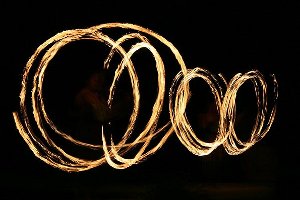 Poi is a performance art using two balls suspended on ropes a person holds in their hands and swings in a variety of circular patterns.
Poi is a performance art using two balls suspended on ropes a person holds in their hands and swings in a variety of circular patterns.
This Monday I started a refresher course in Poi dancing. Yet again, I was doing butterfly moves and the weave while every now and then hitting myself in the back or in the head with a wayward move. Thankfully, I was dancing with practice poi, which are covered tennis balls that don’t hurt very much. There are usually three types of Poi balls used in Poi dancing: practice poi, used by beginners, and glow poi which are LED glowing balls for performance or fire poi which are heavier and are used while lit on fire.
Poi is a performance art using two balls suspended on ropes a person holds in their hands and swings in a variety of circular patterns. The Poi are usually spun in parallel planes, and can be spun in the same direction or in opposite directions. Throwing in moves such as stalls and wraps allows a performer to change between going the same direction to the opposite direction and alternating planes of movement. All of the moves in Poi dancing require having symmetry on both sides of the body. The weave was one of the hardest moves I learned and it took a lot of time and bruises to perfect. It was much later that I was playing with a Halloween sword and swung it around in the same motion that I practice the weave. The sword arched smoothly in my hands.
Although Poi today and its evolution into fire dancing is mostly performative; its origin fostered culture and functional skills. The pre-European Maori used Poi in games and physical exercises to hone reflexes, improve wrist flexibility, increase overall flexibility and improve coordination. Men, women and children would use Poi in action songs and dances that exemplified the culture. Poi were weighted differently depending on the use. Poi used for traditional performance and games were lightweight on ropes less than a meter long. Maori martial arts used balls that were heavily weighted stones on rope between one and five meters long. Their design enabled the user to increase resistance and power. The skill set learned with the heavier Poi transferred to weaponry and fighting skills use by Maori warriors.
The Poi that Maori used was made out of local material. The principal materials used were ropes of intertwined flax from a cabbage tree or palm and the balls were made out of a local swamp plant. In the ancient practice, fire was not used in Maori games, performances or martial arts. But from these sustainable materials and ancient practice Poi dancing has evolved into a beautiful and challenging performance art.
